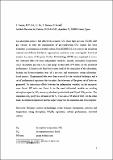Por favor, use este identificador para citar o enlazar a este item:
http://hdl.handle.net/10261/103916COMPARTIR / EXPORTAR:
 SHARE SHARE
 CORE
BASE CORE
BASE
|
|
| Visualizar otros formatos: MARC | Dublin Core | RDF | ORE | MODS | METS | DIDL | DATACITE | |

| Título: | Cyclic operation of a fixed-bed pressure and temperature swing process for CO2 capture: Experimental and statistical analysis |
Autor: | García López, Susana CSIC ORCID; Gil Matellanes, María Victoria CSIC ORCID ; Pis Martínez, José Juan CSIC; Rubiera González, Fernando CSIC ORCID ; Pevida García, Covadonga CSIC ORCID | Palabras clave: | Response surface methodology Cyclic dynamic experiments Pressure and temperature swing adsorption CO2/H2 separation Sorbent performance Activated carbon |
Fecha de publicación: | ene-2013 | Editor: | Elsevier | Citación: | International Journal of Greenhouse Gas Control 12: 35-43 (2013) | Resumen: | An adsorption process that effectively separates CO2 from high pressure CO2/H2 shift gas streams to meet the requirements of pre-combustion CO2 capture has been evaluated. A commercial activated carbon, Norit R2030CO2, was used as the adsorbent material and different batchwise regeneration conditions were investigated. Statistical analysis by means of response surface methodology (RSM) was employed to assess the combined effect of three independent variables, namely, desorption temperature (Tdes), desorption pressure (Pdes) and purge to feed ratio (P/F ratio) on the adsorbent performance. A bench-scale fixed-bed reactor enabled the simulation of the adsorption, heating and depressurization steps of a pressure and temperature swing adsorption-based process. Experimental data were then assessed by the statistical technique and a set of mathematical equations that describes the behaviour of the given set of data were generated. No interaction effects between the independent variables on the responses were found. P/F ratio was found to be the most influential variable on working adsorption capacity, CO2 recovery, adsorbent productivity and H2 and CO2 purities. The maximum CO2 purity was obtained at 60 °C, 5 bar and a P/F ratio of 0.05. On the other hand, desorption temperature had the largest impact on the maximum rate of desorption. | Versión del editor: | http://dx.doi.org/10.1016/j.ijggc.2012.10.018 | URI: | http://hdl.handle.net/10261/103916 | DOI: | 10.1016/j.ijggc.2012.10.018 | ISSN: | 1750-5836 |
| Aparece en las colecciones: | (INCAR) Artículos |
Ficheros en este ítem:
| Fichero | Descripción | Tamaño | Formato | |
|---|---|---|---|---|
| Cyclic_operation_Garcia.pdf | 395,19 kB | Adobe PDF |  Visualizar/Abrir |
CORE Recommender
SCOPUSTM
Citations
31
checked on 24-abr-2024
WEB OF SCIENCETM
Citations
28
checked on 24-feb-2024
Page view(s)
402
checked on 07-may-2024
Download(s)
1.070
checked on 07-may-2024
Google ScholarTM
Check
Altmetric
Altmetric
NOTA: Los ítems de Digital.CSIC están protegidos por copyright, con todos los derechos reservados, a menos que se indique lo contrario.
